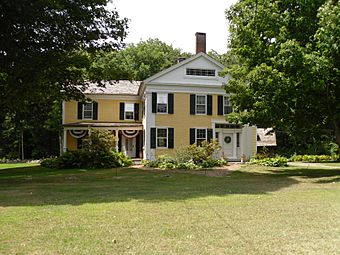Phelps Farms Historic District facts for kids
Quick facts for kids |
|
|
Phelps Farms Historic District
|
|
 |
|
| Location | CT 183 and Prock Hill Rd., Colebrook, Connecticut |
|---|---|
| Area | 35 acres (14 ha) |
| Built | 1832 |
| Built by | Phelps, Arah; Phelps, Edward A. |
| Architectural style | Greek Revival, Gothic Revival |
| NRHP reference No. | 83001249 |
| Added to NRHP | August 18, 1983 |
The Phelps Farm Historic District is a special collection of old farm buildings and homes in Colebrook, Connecticut. You can find it along Connecticut Route 183 and Prock Hill Road. This area is like a time capsule, showing us what a farm looked like in the mid-1800s. What's even cooler is that the same family has owned this land since the 1700s! Because of its history, the district was added to the National Register of Historic Places in 1983.
Contents
Discovering the Phelps Farm Historic District
The Phelps Farm property covers about 35 acres of land. It's located in northern Colebrook, which is a small town in Litchfield County, Connecticut. This area is known for its hills and sits right near Connecticut's northern border.
The farm is bordered by Sandy Brook on its west and south sides. Some of the district's important buildings are found on the east side of CT 183 and Prock Hill Road.
What Makes This Farm Special?
This farm is unique because it has stayed almost exactly the same since the mid-1800s. It shows us how people lived and worked on a farm long ago. The buildings here have different styles, like Greek Revival and Gothic Revival, which were popular back then.
A Look at the Buildings
There are several interesting buildings in the Phelps Farm Historic District. Each one tells a part of the farm's story.
The Arah Phelps Inn
One of the most important buildings is the Arah Phelps Inn. You'll find it right where CT 183 and Prock Hill Road meet. This beautiful house was built in the Federal style, which was common in the late 1700s and early 1800s. The Phelps family didn't just live here; they also ran it as a tavern, a place where travelers could stop for food and rest.
Edward Phelps' Home and Other Buildings
On the west side of the road, you'll see the house of Edward Phelps. This home is built in the Greek Revival style, which means it looks a bit like ancient Greek temples. There are also several other farm buildings from the 1800s nearby. Edward Phelps also built a lovely Gothic Revival cottage. This cottage was used to house the people who worked on the farm. Most of the land around these buildings is still open pasture, just as it was years ago.
A Family's Legacy: From Mill to Inn
The story of Phelps Farm really began in the 1780s. That's when Arah Phelps built a sawmill by damming Sandy Brook. In 1793, Arah and his father, Josiah, built the inn. Soon, the inn became a busy spot and the center of a small community.
The road (now CT 183) was part of a major stagecoach route. This route connected Hartford, Connecticut to Albany, New York. Because of this, the inn was very successful. Arah Phelps not only ran the tavern and the mill, but he also sold products from his own farm at the inn.
In the 1830s, Arah's son, Edward, took over the property. Many of the farm buildings you see today were built during his time.
Protecting History for the Future
Even though the family faced some challenges in the early 1900s, members of the Phelps family continued to own most of the land. Today, more than 300 acres of the land around the farm have been given to the Nature Conservancy. This helps protect the natural environment. The farm buildings themselves are also protected by an agreement with Historic New England. This ensures that this important piece of history will be preserved for many years to come.



